When Just One Benchtop Material Isn't Enough
Challenge the perfect, polished kitchen by combining more than one benchtop material for a truly unique and practical space
Mix and matching kitchen cupboard doors is a big trend, and now we’re seeing this marrying of materials happening in benchtops too. Combining different styles of benchtops in contrasting colours and textures is an effective way of adding instant impact. An added bonus is that you can create a hard-working space that can be tailor-designed to suit the different functions of each area – such as a heat-resistant top for the cooking zone and a warm-to-touch wood for the eating area – at the same time.
What’s more, combining materials can help stretch your budget further too. If you’ve had your eye on an expensive slab of marble or stunning hardwood for example, you’ll be able to use it in a small area as a focal point while fitting something more affordable in the rest of the room. So whatever your style or taste, there’s definitely room for more than one benchtop material in your kitchen.
What’s more, combining materials can help stretch your budget further too. If you’ve had your eye on an expensive slab of marble or stunning hardwood for example, you’ll be able to use it in a small area as a focal point while fitting something more affordable in the rest of the room. So whatever your style or taste, there’s definitely room for more than one benchtop material in your kitchen.
A uniform look
Kitchen designs that feature benchtops in the same finish as the units can create a smart, uniform look, and this is a good design rule to stick to when combining different materials to avoid the space looking overcrowded. If you are mixing a timber with a coloured surface and units, consider the tone of the wood. Colour varies within wooden benchtops, and the result can feel either warm or cool. Pairing wood with the right colour is crucial. Combos that work well are pale oak with deep grey and rich walnut with cool green.
Kitchen designs that feature benchtops in the same finish as the units can create a smart, uniform look, and this is a good design rule to stick to when combining different materials to avoid the space looking overcrowded. If you are mixing a timber with a coloured surface and units, consider the tone of the wood. Colour varies within wooden benchtops, and the result can feel either warm or cool. Pairing wood with the right colour is crucial. Combos that work well are pale oak with deep grey and rich walnut with cool green.
Practical finishes
Keen bakers will know the benefits of rolling dough on a chilled surface (it doesn’t stick so much) so why not include a slab of marble or granite at the end of a wood or laminate bench to do the job? It will make an interesting feature, as well as a practical area for popping hot cake tins or saucepans. Easy to wipe down too, this is a brilliant solution for busy kitchens that want a relaxed yet functional working space.
Benchtop options for bakers
Keen bakers will know the benefits of rolling dough on a chilled surface (it doesn’t stick so much) so why not include a slab of marble or granite at the end of a wood or laminate bench to do the job? It will make an interesting feature, as well as a practical area for popping hot cake tins or saucepans. Easy to wipe down too, this is a brilliant solution for busy kitchens that want a relaxed yet functional working space.
Benchtop options for bakers
Raw edge
Polished concrete benchtops make a stunning statement and are perfect for channelling a trendy industrial look. However, the rawness of its texture and finish can feel a little cold and uninviting for an eating area, so try teaming it with a super smooth and cleaner-looking surface, such as a composite. Composites are manmade materials, using rock minerals suspended in tough resin. They are stain-resistant, easy to care for and anti-bacterial, making them so clean you could eat your dinner off of them.
Polished concrete benchtops make a stunning statement and are perfect for channelling a trendy industrial look. However, the rawness of its texture and finish can feel a little cold and uninviting for an eating area, so try teaming it with a super smooth and cleaner-looking surface, such as a composite. Composites are manmade materials, using rock minerals suspended in tough resin. They are stain-resistant, easy to care for and anti-bacterial, making them so clean you could eat your dinner off of them.
Colour blocks
Laminate surfaces are the most affordable option, and are particularly hard-wearing thanks to their tough coating wrapped around high-density chipboard, plywood or MDF. They also come in a whole host of colours, so your design choice is unlimited. Here, they’ve been paired with a more practical and pared-back stainless-steel benchtop around the washing-up area, for ease of use, as well as water- and heat-resistance.
Laminate surfaces are the most affordable option, and are particularly hard-wearing thanks to their tough coating wrapped around high-density chipboard, plywood or MDF. They also come in a whole host of colours, so your design choice is unlimited. Here, they’ve been paired with a more practical and pared-back stainless-steel benchtop around the washing-up area, for ease of use, as well as water- and heat-resistance.
The professional touch
Stainless-steel benchtops are super-hygienic, and can withstand heat, water and stains; their use in commercial kitchens is testament this. However, steel is pretty chilly to touch, and it does scratch so it’s probably not the ideal material for a breakfast bar which sees a lot of cutlery action. Pairing it with a similarly smooth and sleek surface for the eating area, such as limestone, will make your serious home cooking space welcoming yet super-functional.
16 tough-talking tips from pro kitchens
Stainless-steel benchtops are super-hygienic, and can withstand heat, water and stains; their use in commercial kitchens is testament this. However, steel is pretty chilly to touch, and it does scratch so it’s probably not the ideal material for a breakfast bar which sees a lot of cutlery action. Pairing it with a similarly smooth and sleek surface for the eating area, such as limestone, will make your serious home cooking space welcoming yet super-functional.
16 tough-talking tips from pro kitchens
Opposites attract
Marble has seen a huge resurgence in popularity throughout the kitchen, with its bold veining adding drama to surfaces, splashbacks and breakfast islands. However, it’s also pretty dramatic on the wallet, and as each slab of natural marble varies in colour and pattern, so does the price – expect to pay upwards of $800 per square metre. Therefore, dedicating a sizeable chunk of work surface to another material, such as wood or laminate, will save you a fortune and still retain that classic look.
Marble has seen a huge resurgence in popularity throughout the kitchen, with its bold veining adding drama to surfaces, splashbacks and breakfast islands. However, it’s also pretty dramatic on the wallet, and as each slab of natural marble varies in colour and pattern, so does the price – expect to pay upwards of $800 per square metre. Therefore, dedicating a sizeable chunk of work surface to another material, such as wood or laminate, will save you a fortune and still retain that classic look.
Cool monochrome
If you want to play it calm and collected with a sophisticated black and white palette, consider upping the ante with a standout island. Choose wrap-around black benchtops to bring focus to this central feature, and white surfaces for the rest of the space so it feels light and bright.
If you want to play it calm and collected with a sophisticated black and white palette, consider upping the ante with a standout island. Choose wrap-around black benchtops to bring focus to this central feature, and white surfaces for the rest of the space so it feels light and bright.
Compare and contrast
Galley kitchens can often feel a little featureless, thanks to their long and narrow layout. Try raising the pulse by mixing some rough with the smooth. A chunky, super-tough concrete benchtop opposite a super-skinny porcelain surface will create a stunning contrast that’s sure to get your heart racing.
TELL US
What benchtop materials have you combined in your kitchen? Tell us in the Comments below.
MORE
Browse more stunning kitchen designs
Galley kitchens can often feel a little featureless, thanks to their long and narrow layout. Try raising the pulse by mixing some rough with the smooth. A chunky, super-tough concrete benchtop opposite a super-skinny porcelain surface will create a stunning contrast that’s sure to get your heart racing.
TELL US
What benchtop materials have you combined in your kitchen? Tell us in the Comments below.
MORE
Browse more stunning kitchen designs


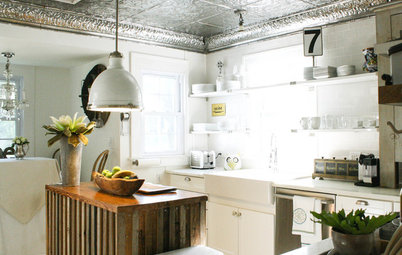
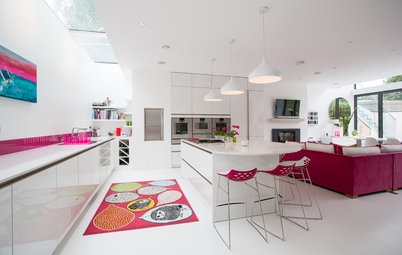
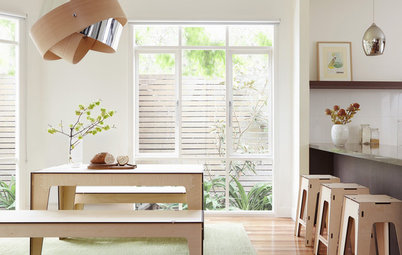
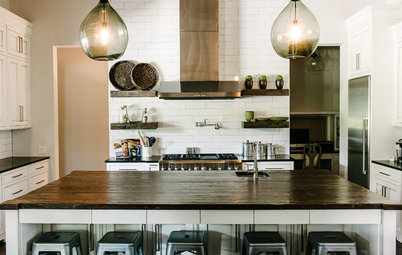
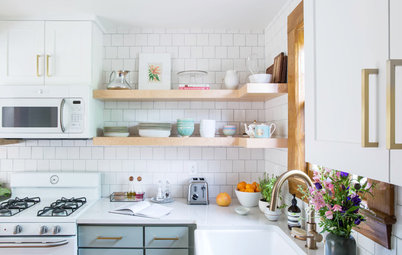
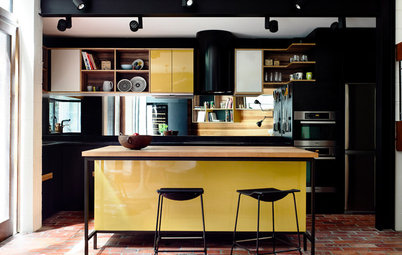
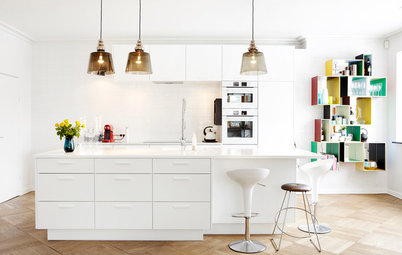
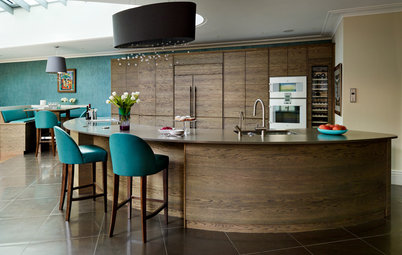
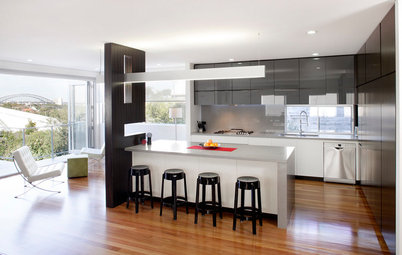
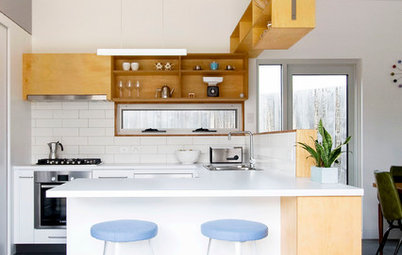
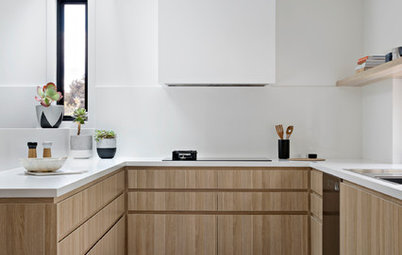
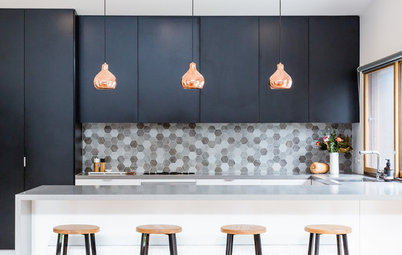
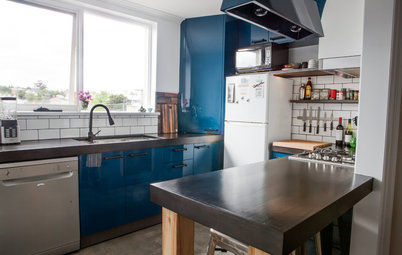
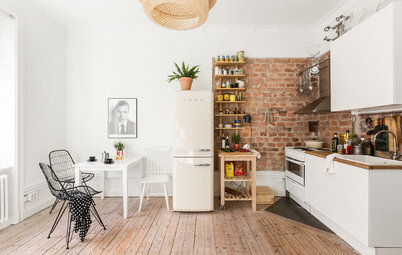
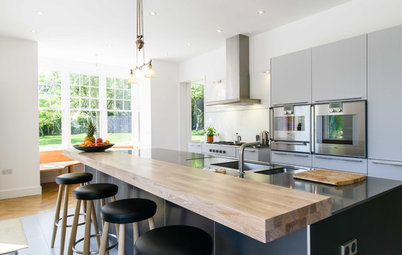
Wood is the stalwart of the kitchen surface, but if you’re keen to try something a bit different, try teaming it with a contemporary composite or natural stone and you’re sure to see a much more exciting result.
Many people pick timber for its good looks, but it needs regular oiling when used around the stove and sink to prevent scorching and water damage. Therefore, if you still want your kitchen to display the beauty of wood, but are unsure if timber benchtops are practical, use wood just in the eating area and you’ll save yourself a heap of time on maintenance. I love the combination of distinctive wood grains, such as zebrawood or iroko, teamed with modern pale surfaces, such as limestone.
What benchtop’s best for you?